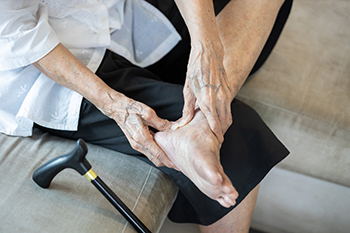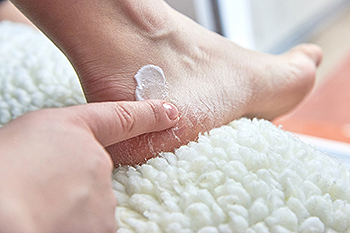Items filtered by date: December 2022
Common Foot Conditions Among the Elderly

Foot problems may increase among the senior population. This is often a result of thinning fat pads in the heel, and the foot structure may change as the aging process occurs. The circulation may diminish, and this can affect the healing of cuts and scrapes that are on the feet. Many people wear shoes that do not fit correctly, and they may gradually develop specific foot conditions that can worsen during their senior years. These can include bunions, corns, and hammertoes, and medical attention from a podiatrist is often sought. Toenail fungus may be common among elderly people, which may happen when the blood flow is reduced to the feet, possibly resulting in dry and brittle nails. It is strongly advised that older people are regularly seen by a podiatrist, who can diagnose and provide the correct treatment for any foot condition.
If you need your feet checked, contact Dan Kirk, DPM of Bluffton Foot & Ankle. Our doctor will attend to all of your foot and ankle needs and provide you with quality treatment.
Geriatrics and Podiatry
When people age, some common issues that may occur are bone density loss, dry skin, poor circulation, and rough brittle nails. These issues may also affect your foot health if the necessary steps are not taken to alleviate the problems.
It is important to take care of your feet because feet that are injured or diseased can affect your overall health. Having painful feet hinders your ability to do daily activities or may decrease your willingness to do the things that you need to do.
Visiting Your Geriatrician
As we age, health problems become more likely, so it is essential to visit your doctor for check-ups to ensure that you are doing the best you can to take care of your health. It is recommended to check your feet frequently for any possible cuts, bruises, swelling, corns or any other irregularities.
Taking Care of Elderly Feet
Cracked or dry feet can be treated by applying moisturizer often. It is also important not to wear old socks because the older the sock is, the higher the possibility there will be that there is bacteria there. Wear fresh socks and make sure they fit properly.
Proper foot health means that you can have a more active lifestyle and you will not be bogged down by pain. Foot health also leads to good circulation, which is paramount for overall health.
If you have any questions, please feel free to contact our offices located in Bluffton and Celina, OH . We offer the newest diagnostic tools and technology to treat your foot and ankle needs.
Plantar Fasciitis From Golf

Plantar fasciitis is inflammation of the plantar fascia, the thick band of connective tissue that supports the bottom of the foot. It is most often associated with high impact activities, like running, soccer, and football. One would not normally think of this condition with respect to a low impact game, like golf. However, in addition to trauma to the plantar fascia from high impact sports, plantar fasciitis can be caused by chronic overuse. Golf involves prolonged standing and walking. This can gradually flatten, inflame, and cause small tears in the arch of the foot, leading to heel pain and plantar fasciitis. Improperly swinging the golf club can also be a risk factor for plantar fasciitis. If one overextends while swinging, particularly while wearing shoes that do not support the heel and that might allow the foot to slide around, plantar fasciitis can result. Symptoms of this condition include extreme pain in the heel when walking, especially first thing in the morning. If you feel heel and arch pain that is interfering with your golf game and walking in general, consult with a podiatrist who can make an accurate diagnosis and provide treatment.
Sports related foot and ankle injuries require proper treatment before players can go back to their regular routines. For more information, contact Dan Kirk, DPM of Bluffton Foot & Ankle. Our doctor can provide the care you need to keep you pain-free and on your feet.
Sports Related Foot and Ankle Injuries
Foot and ankle injuries are a common occurrence when it comes to athletes of any sport. While many athletes dismiss the initial aches and pains, the truth is that ignoring potential foot and ankle injuries can lead to serious problems. As athletes continue to place pressure and strain the area further, a mild injury can turn into something as serious as a rupture and may lead to a permanent disability. There are many factors that contribute to sports related foot and ankle injuries, which include failure to warm up properly, not providing support or wearing bad footwear. Common injuries and conditions athletes face, including:
- Plantar Fasciitis
- Plantar Fasciosis
- Achilles Tendinitis
- Achilles Tendon Rupture
- Ankle Sprains
Sports related injuries are commonly treated using the RICE method. This includes rest, applying ice to the injured area, compression and elevating the ankle. More serious sprains and injuries may require surgery, which could include arthroscopic and reconstructive surgery. Rehabilitation and therapy may also be required in order to get any recovering athlete to become fully functional again. Any unusual aches and pains an athlete sustains must be evaluated by a licensed, reputable medical professional.
If you have any questions please feel free to contact our offices located in Bluffton and Celina, OH . We offer the newest diagnostic and treatment technologies for all your foot and ankle needs.
Dealing With Heel Fissures

A heel fissure develops when the skin on your feet is so dry that cracks begin to form on the heels. The cracked skin also may become flakey and crusty and can develop into brown or yellow calluses caused by pressure on the back of the heels when you stand or walk. Although the cracks may at first be shallow, in some cases they deepen into heel fissures and cause pain and bleeding. The best way to deal with dry skin on the heels is to gently remove the dry skin with a pumice stone after a bath or shower and follow up with emollient cream to keep the heels moisturized. If cracked heels are left untreated, they can lead to infection, and the skin may form ulcers. A podiatrist can safely debride the dead skin and treat the affected area with antifungal and antibacterial medication to ward off any infection. Special orthotics can be inserted into your shoes with heel cups that help to keep the skin from cracking. For more information, or to have painful heel fissures treated, please make an appointment with a podiatrist.
Wound care is an important part in dealing with diabetes. If you have diabetes and a foot wound or would like more information about wound care for diabetics, consult with Dan Kirk, DPM from Bluffton Foot & Ankle. Our doctor will assess your condition and provide you with quality foot and ankle treatment.
What Is Wound Care?
Wound care is the practice of taking proper care of a wound. This can range from the smallest to the largest of wounds. While everyone can benefit from proper wound care, it is much more important for diabetics. Diabetics often suffer from poor blood circulation which causes wounds to heal much slower than they would in a non-diabetic.
What Is the Importance of Wound Care?
While it may not seem apparent with small ulcers on the foot, for diabetics, any size ulcer can become infected. Diabetics often also suffer from neuropathy, or nerve loss. This means they might not even feel when they have an ulcer on their foot. If the wound becomes severely infected, amputation may be necessary. Therefore, it is of the upmost importance to properly care for any and all foot wounds.
How to Care for Wounds
The best way to care for foot wounds is to prevent them. For diabetics, this means daily inspections of the feet for any signs of abnormalities or ulcers. It is also recommended to see a podiatrist several times a year for a foot inspection. If you do have an ulcer, run the wound under water to clear dirt from the wound; then apply antibiotic ointment to the wound and cover with a bandage. Bandages should be changed daily and keeping pressure off the wound is smart. It is advised to see a podiatrist, who can keep an eye on it.
If you have any questions, please feel free to contact our offices located in Bluffton and Celina, OH . We offer the newest diagnostic and treatment technologies for all your foot care needs.
Subspecialties in Podiatry

Podiatrists are foot specialists in the medical field that can help treat a wide variety of foot conditions in their patients. Podiatrists can diagnose and treat foot conditions such as plantar fasciitis, athlete’s foot, Achilles tendonitis, heel spurs, and so much more. Importantly, there are many subspecialties in the field of podiatry that a podiatrist might be acquainted with. One popular subspecialty in podiatry is known as sports medicine. These podiatrists deal specifically with athletes and are very familiar with particular foot afflictions that affect this group of people. These podiatrists know a great deal about the biomechanics of the foot and rehabilitation techniques. Contact a podiatrist today with additional questions about what they do and what they specialize in.
If you are experiencing pain in the feet or ankles, don’t join the stubborn majority refusing treatment. Feel free to contact Dan Kirk, DPM from Bluffton Foot & Ankle. Our doctor can provide the care you need to keep you pain-free and on your feet.
What Is a Podiatrist?
Someone would seek the care of a podiatrist if they have suffered a foot injury or have common foot ailments such as heal spurs, bunions, arch problems, deformities, ingrown toenails, corns, foot and ankle problems, etc.
Podiatric Treatment
A podiatrist will treat the problematic areas of the feet, ankle or lower leg by prescribing the following:
- Physical therapy
- Drugs
- Orthotic inserts or soles
- Surgery on lower extremity fractures
A common podiatric procedure a podiatrist will use is a scanner or force plate which will allow the podiatrist to know the designs of orthotics. Patients are then told to follow a series of tasks to complete the treatment. The computer will scan the foot a see which areas show weight distribution and pressure points. The podiatrist will read the analysis and then determine which treatment plans are available.
If you have any questions please feel free to contact our offices located in Bluffton and Celina, OH . We offer the newest diagnostic and treatment technologies for all your foot and ankle needs.

